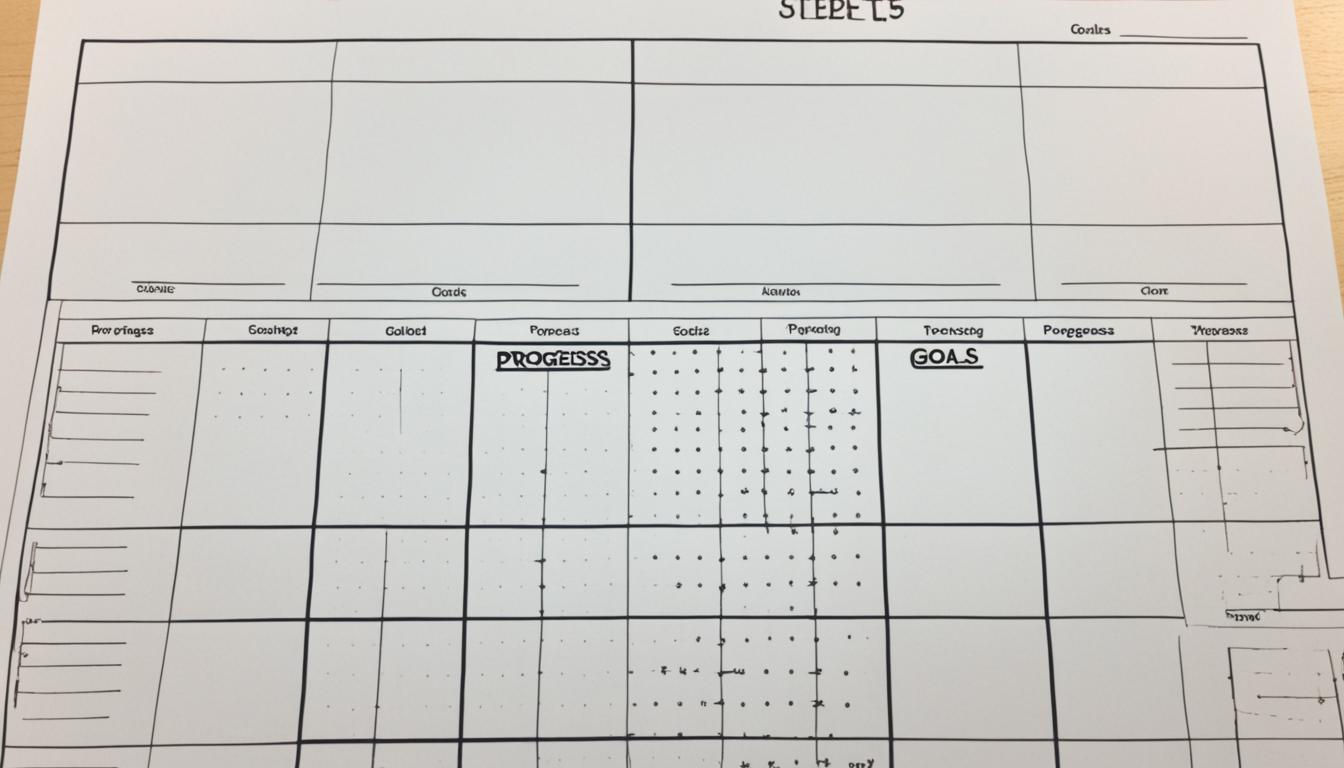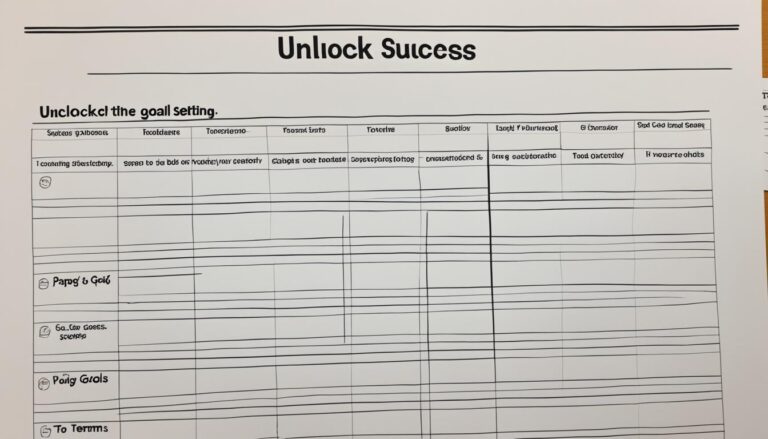Achieve Dreams with Middle School Goal Setting Worksheet

“The future belongs to those who believe in the beauty of their dreams.” – Eleanor Roosevelt
Goal setting skills are essential for young people, empowering students to strive for self-improvement and have control over their own lives. Middle school is a transformative period where students experience physical, emotional, and intellectual changes. It is a critical time for students to develop their identity, understand their capabilities, and recognize their potential.
Introducing goal setting during this period can help students take control of their lives and set the stage for future success. By setting specific, measurable, attainable, realistic, and time-bound goals, students can enhance their self-image, increase self-awareness, and gain a sense of direction and purpose.
Teachers play a crucial role in teaching and supporting goal setting in middle school. They can guide students in identifying their goals, developing action plans, and reflecting on their progress. Providing opportunities for practice and using tools such as a middle school goal setting worksheet can further enhance the learning experience.
Key Takeaways:
- Goal setting empowers middle school students to strive for self-improvement and control over their lives.
- Setting specific, measurable, attainable, realistic, and time-bound goals is important for success.
- Teachers play a crucial role in teaching and supporting goal setting in middle school.
- Using tools like a middle school goal setting worksheet can enhance the learning experience.
- Goal setting during middle school promotes self-awareness, direction, and purpose.
The Importance of Goal Setting in Middle School
Middle school is a transformative period in a student’s life, marked by significant physical, emotional, and intellectual changes. It is during this time that young individuals begin to shape their identities, discover their capabilities, and realize their potential. By introducing goal setting in middle school, students are empowered to take control of their lives and lay the foundation for future success.
Setting and achieving goals in middle school is not solely about academic achievements; it encompasses personal growth, self-improvement, and the development of essential life skills. By setting specific objectives, students can enhance their self-image, increase self-awareness, and gain a sense of direction and purpose.
Goal setting provides students with numerous benefits, both inside and outside the classroom. It fosters a growth mindset, instilling in students the belief that their efforts and abilities can lead to significant achievements. It also helps students develop essential skills such as time management, planning, perseverance, and resilience.
Improved Middle School Achievement
When students set goals in middle school, they gain a clear focus and direction. They become more driven to succeed academically, as they have a target to strive for. By setting specific and measurable academic goals, such as improving grades or mastering challenging subjects, students are motivated to put in the necessary effort and concentrate on their studies. This increased commitment often leads to improved middle school achievement.
Enhanced Self-Image and Self-Awareness
Goal setting in middle school plays a crucial role in shaping a student’s self-image and self-awareness. By setting and achieving goals, students gain a sense of accomplishment and build their self-confidence. They begin to recognize their strengths and areas for growth, enabling them to make informed decisions about their academic and personal pursuits. This self-awareness helps students make choices that align with their interests, passions, and abilities.
A Sense of Direction and Purpose
Goal setting in middle school provides students with a sense of direction and purpose. It helps them define what they want to achieve and why it is significant to them. Setting meaningful goals, whether they are academic, extracurricular, or personal, allows students to navigate their middle school years with purpose and meaning. This sense of direction helps students stay focused, make informed choices, and stay resilient in the face of challenges.

| Benefits of Goal Setting in Middle School |
|---|
| Improved academic achievements |
| Enhanced self-image and self-awareness |
| A sense of direction and purpose |
The SMART Method for Middle School Goal Setting
When it comes to goal setting, the SMART method is a powerful framework that can help middle school students achieve success. SMART stands for Specific, Measurable, Achievable, Relevant, and Time-bound, providing a clear roadmap for goal setting activities. By following the SMART approach, students can set meaningful and attainable goals that align with their interests and aspirations.
Let’s break down each component of the SMART method:
- Specific: Goals should be well-defined and precise. Instead of setting a broad goal like “improve grades,” students can set a specific goal like “earn an ‘A’ in math by the end of the semester.”
- Measurable: Goals should be quantifiable so that progress can be tracked. Students can set measurable goals by including specific criteria for success. For example, “complete all homework assignments on time for the entire week.”
- Achievable: Goals should be within reach and realistic. While it’s important to challenge oneself, setting overly ambitious goals can lead to frustration and demotivation. Students should set goals that are challenging yet attainable, considering their abilities and available resources.
- Relevant: Goals should be relevant to the student’s life and aspirations. Students should ask themselves, “How does this goal align with my values and long-term objectives?” Setting goals that are meaningful and personally relevant increases motivation and commitment.
- Time-bound: Goals should have a timeline or deadline. This provides students with a sense of urgency and helps them prioritize their actions. A time-bound goal could be “improve vocabulary by learning five new words every day for the next month.”
Implementing the SMART method not only helps students set clear and focused goals, but it also encourages them to develop effective action plans and monitor their progress. By breaking goals into smaller, manageable steps and creating a timeline, students can stay on track and overcome obstacles along the way.
Regular check-ins and reflections are crucial components of the SMART method. Students should assess their progress, make any necessary adjustments, and celebrate their achievements. These moments of reflection provide valuable insights and help students learn from their experiences.
Ready to put the SMART method into action? Let’s take a look at an example of a SMART goal using the SMART method:
| Component | Example Goal |
|---|---|
| Specific | Earn an ‘A’ in science by the end of the semester |
| Measurable | Complete all assigned readings and assignments for science class on time and earn a minimum of 90% on all exams and quizzes |
| Achievable | Dedicate at least 2 hours of focused study time to science each week and seek help from the teacher or classmates when needed |
| Relevant | Achieving a high grade in science is important for pursuing a future career in the medical field |
| Time-bound | Earn an ‘A’ in science by the end of the semester |
Implementing the SMART Method: A Step-by-Step Process
Now that you understand the SMART method, here’s a step-by-step process to help you apply it:
- Identify your goal and make sure it meets the SMART criteria.
- Create an action plan by breaking your goal into smaller, manageable steps.
- Set deadlines for each step to stay on track.
- Regularly assess your progress and make any necessary adjustments to your action plan.
- Celebrate your achievements along the way.
By using the SMART method, you’ll be able to set goals that are aligned with your aspirations, develop effective action plans, and stay motivated on your path to success.
Teaching Goal Setting in Middle School
Educators play a crucial role in guiding middle school students on their goal-setting journey. By introducing the concept of goal setting through lessons, discussions, and activities, teachers can empower students to identify their goals, develop action plans, and reflect on their progress. Creating a positive and encouraging environment is essential for motivating students to set and achieve their goals.
One effective way to support students in their goal-setting process is to provide them with resources such as goal setting worksheets, role-playing scenarios, and vision boards. These tools can enhance the learning experience and help students visualize their aspirations. For instance, a student goal planner can enable students to record their goals, break them down into actionable steps, and track their progress.
Benefits of Teaching Goal Setting in Middle School
- Personal Development: Goal setting helps students cultivate valuable skills such as time management, resilience, and self-discipline.
- Increased Motivation: When students have clear goals and a roadmap to achieve them, they are more inclined to stay focused and motivated.
- Improved Self-Awareness: The goal-setting process encourages students to reflect on their strengths, weaknesses, and interests, fostering self-awareness and self-discovery.
- Enhanced Decision-Making: Setting and pursuing goals in middle school can teach students how to make informed choices and prioritize their actions.

By teaching goal setting in middle school, educators can instill valuable life skills in students that extend beyond the academic realm. Through their guidance, students can learn to set meaningful goals, take ownership of their actions, and develop a growth mindset to overcome challenges.
Goal Setting for Academic Success in Middle School
Achieving academic success in middle school requires more than just attending classes and completing assignments. It involves setting clear and tangible goals that propel you toward excellence. By setting educational goals, you can optimize your performance, develop essential skills, and unlock your full potential. Let’s explore how goal setting can pave the path to middle school success.
The Power of Academic Goals
Academic goals provide a roadmap for your educational journey. By defining specific objectives, such as improving grades or completing assignments on time, you establish a clear direction and focus for your studies.
When you set academic goals, you cultivate a strong work ethic and enhance your motivation. These goals act as guiding beacons, reminding you of the importance of your studies and encouraging you to stay on track.
Guidance from Teachers
Teachers play a crucial role in helping you set and achieve your academic goals. They possess valuable insights and knowledge to guide you throughout your middle school journey. Reach out to your teachers for guidance, and work together to develop realistic goals that align with your interests and abilities.
Teachers can provide support and monitoring to ensure you’re making progress toward your goals. They can offer valuable feedback, identify areas for improvement, and help you overcome challenges along the way.
Developing Key Skills
Goal setting for academic success in middle school not only improves your grades but also nurtures essential skills that will benefit you throughout your educational journey and beyond.
One such skill is time management. By setting specific deadlines for your assignments and breaking larger tasks into manageable chunks, you’ll learn to prioritize and make the most of your time. This skill will help you succeed not only in middle school but also in high school, college, and your future career.
Another critical skill is prioritization. By setting academic goals, you learn to identify the most important tasks and allocate your time and energy accordingly. This ability to prioritize will serve you well as you navigate through the demands of school and life.
Visualizing Your Progress
Tracking your progress is crucial when it comes to goal setting for academic success. It helps you stay motivated and provides a sense of achievement as you witness your improvement over time.
Consider using a middle school goal tracking worksheet to record your goals, milestones, and progress. This visual representation of your journey can be both empowering and inspiring, keeping you focused on your academic ambitions.
| Benefits of Goal Setting for Academic Success in Middle School |
|---|
| Enhanced work ethic and motivation |
| Improved time management skills |
| Development of prioritization skills |
| Increased self-awareness and self-discipline |
| Improved academic performance |

Goal setting for academic success in middle school is an essential tool for your growth and development. By setting clear goals, seeking guidance from your teachers, and developing key skills, you can pave the way for a prosperous educational journey. Remember, each step you take brings you closer to realizing your full potential and achieving your dreams.
Promoting Personal Growth and Development in Middle School
Goal setting goes beyond academic success; it also promotes personal growth and development. By setting goals related to personal interests, hobbies, or self-improvement, you can cultivate your talents, explore new opportunities, and develop a sense of purpose.
When you set goals that align with your passions and values, you foster a growth mindset and resilience. Middle school is the perfect time to discover your strengths and work on areas of improvement. By setting goals to enhance your skills and knowledge, you lay the foundation for lifelong learning and personal fulfillment.
Unleashing Your Potential Through Goal Setting
Setting personal goals in middle school allows you to uncover your hidden talents and explore new horizons. Whether it’s learning a musical instrument, writing a novel, or pursuing a sport, the act of setting goals pushes you to step out of your comfort zone and embrace challenges.
Goal setting helps you develop important life skills such as determination, perseverance, and resilience. It teaches you the value of hard work and the rewards that come with it. As you achieve your personal goals, you gain confidence in your abilities and develop a sense of fulfillment like no other.
Inspire your personal growth and development by setting SMART goals:
- Specific: Define your goals in clear and specific terms. What is it that you want to achieve?
- Measurable: Set goals that you can track and measure. Break them down into smaller milestones so you can monitor your progress.
- Achievable: Set goals that are within your reach. While it’s important to challenge yourself, make sure your goals are realistic and attainable.
- Relevant: Align your goals with your interests and passions. Choose goals that are meaningful to you and reflect your values.
- Time-bound: Set a timeline for achieving your goals. This will help you stay focused and motivated.
The Power of Visualization
Visualization is a powerful tool that can help you achieve your goals. Take a moment to picture yourself successfully reaching your personal goals. Visualize the steps you need to take, the obstacles you may encounter, and the joy you will feel when you accomplish your goals.
Creating a vision board is a great way to bring your goals to life. Use images, quotes, and symbols that represent your aspirations and place them somewhere visible. It will serve as a constant reminder of what you’re working towards and keep you motivated during challenging times.

| Benefits of Personal Goal Setting in Middle School | |
|---|---|
| 1. Enhanced self-confidence and self-esteem. | 4. Improved time management skills. |
| 2. Increased self-awareness and self-discovery. | 5. Greater sense of purpose and direction. |
| 3. Development of resilience and perseverance. | 6. Cultivation of personal interests and passions. |
By setting personal goals in middle school, you open doors to endless possibilities. Embrace the power of goal setting and embark on a journey of personal growth and development that will shape your future.
Goal Setting Strategies for Middle School Students
To effectively set and achieve goals in middle school, you can utilize various strategies that will support your progress and success. By implementing these strategies, you’ll be able to build self-confidence, resilience, and a sense of accountability.
Break Goals into Smaller Steps
One effective strategy is to break your goals into smaller, more manageable steps. By doing this, you’ll avoid feeling overwhelmed and increase your chances of success. Each step will bring you closer to achieving your ultimate goal, providing a sense of accomplishment along the way.
Create Action Plans
Alongside breaking your goals into smaller steps, it’s essential to create action plans. These plans outline the specific tasks and actions you need to take to reach your goals. By having a clear plan in place, you’ll have a roadmap to follow, ensuring that you stay focused and on track.
Track Your Progress
Tracking your progress is crucial in goal setting. It allows you to monitor your advancement, identify any areas where you may need to make adjustments, and celebrate your achievements. You can use a variety of methods to track your progress, such as using a journal, creating a checklist, or using a digital tool.
Seek Support
Don’t be afraid to seek support from your peers and adults. Discussing your goals with others can provide valuable insights, advice, and encouragement. You can also find mentors who can guide you on your journey, offering wisdom and support along the way.
Reflect on Your Experiences
Reflection is a critical step in goal setting. Taking the time to reflect on your experiences allows you to assess what worked well and what areas you can improve upon. It’s an opportunity for self-awareness and growth, helping you refine your approach and set new goals moving forward.
Middle School Goal Setting Worksheet
A valuable tool that can assist you throughout your goal setting journey is a middle school goal setting worksheet. This worksheet provides a structured framework for clarifying your goals, creating action plans, and monitoring your progress. Use it to record your goals, outline the steps you need to take, and track your achievements.
| Goal Setting Worksheet |
|---|
By incorporating these goal setting strategies into your middle school experience, you’ll be well-equipped to tackle challenges, achieve your aspirations, and experience personal growth and achievement.
Conclusion
Goal setting is a crucial skill for middle school students to develop. It empowers you to take control of your life and work towards your dreams and aspirations. By using the SMART (Specific, Measurable, Achievable, Relevant, Time-bound) method and implementing goal setting strategies, you can set meaningful goals that align with your interests and values.
Creating action plans and breaking down your goals into manageable steps will help you stay focused and motivated. Tracking your progress and reflecting on your experiences will allow you to make necessary adjustments and celebrate your achievements along the way.
Educators play a vital role in teaching and supporting goal setting in middle school. They can provide guidance, resources, and middle school goal setting worksheets to help you clarify your goals, develop action plans, and monitor your progress. With the right tools and support, you have the ability to achieve your dreams and unlock your full potential. Start setting your goals today and embark on an exciting journey of self-improvement and success!
FAQ
Why is goal setting important for middle school students?
Goal setting is important for middle school students because it empowers them to strive for self-improvement and have control over their own lives. It helps them develop their identity, understand their capabilities, and recognize their potential.
What is the goal-setting model for grades 6-8?
The goal-setting model for grades 6-8 involves three steps: identifying a goal, creating an action plan, and reflecting on the outcome. It is important to set specific, measurable, attainable, realistic, and time-bound goals.
How can teachers support goal setting in middle school?
Teachers can support goal setting in middle school by introducing the concept through lessons, discussions, and activities. They can provide guidance and resources such as goal setting worksheets and create a positive, encouraging environment for students.
How can goal setting contribute to academic success in middle school?
Goal setting can contribute to academic success in middle school by improving performance, developing a strong work ethic, and teaching valuable skills like time management and prioritization.
How does goal setting promote personal growth and development in middle school?
Goal setting promotes personal growth and development in middle school by allowing students to cultivate their talents, explore new opportunities, and develop a sense of purpose. It fosters a growth mindset and resilience.
What strategies can middle school students use for goal setting?
Middle school students can use strategies such as breaking goals into smaller steps, creating action plans, tracking progress, seeking support, and reflecting on their experiences.






